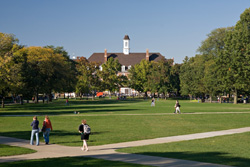ASHRAE and Educational Institutions: Shaping Tomorrow’s Built Environment Today

ASHRAE universities and colleges recognize that enhancing our base of knowledge in all disciplines leads to a better world for everyone. This is particularly important in the areas related to the built environment industry given that, as the industry that makes the biggest impact on the environment, we have a greater opportunity to reduce that impact.
We already have the technology available to drastically reduce that impact in buildings – the time has come to take the existing technology, build upon that by embracing change, pushing the boundaries and engaging all of the stakeholders in building design, construction and operation.
That’s why the role of universities and colleges is so important – you bring together the leaders of today with the leaders of tomorrow to share their knowledge, work together, share ideas and advance the standards of practice to improve the built environment.
Through its varied resources, including research, student branches and publications, ASHRAE supports your efforts. These resources support your professors, researchers and other staff in their day-to-day work, guiding students as they learn about the environment in which they live.
Here are a few ways in which ASHRAE helps you shape tomorrow’s built environment today.